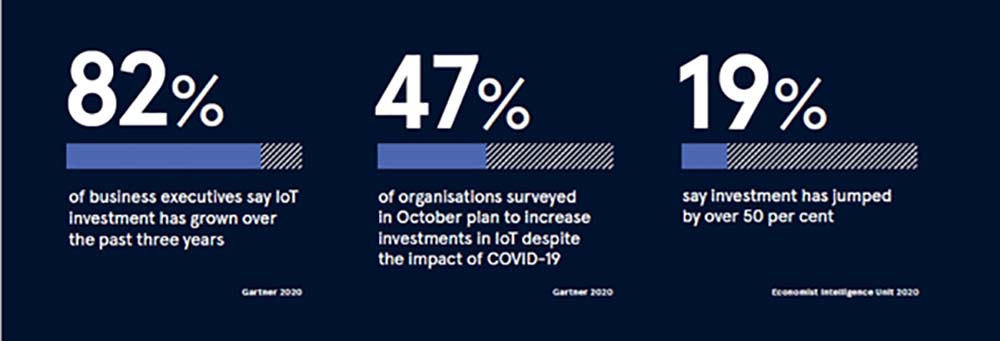No one could have predicted that 2020 would be such a test of our collective resilience. Yet it also highlighted how humans take adversity and turn it into a force for good on a daily basis. As we enter 2021, a new suite of COVID-19 vaccines brings us much-needed hope, and we also face a new question: do we want to build back to where we were in 2019 or build up stronger than before?
 Security offers a competitive advantage as businesses’ investment in IoT grows.
Security offers a competitive advantage as businesses’ investment in IoT grows.
Businesses have been forced to adapt to new ways of working throughout the pandemic. Companies have implemented the Internet of Things (IoT) as part of their long-term enterprise transformation, with more than 47 percent of organizations planning to continue their investments. As the IoT forms the foundation of many enterprises’ core processes, businesses will need to ensure that both devices (i.e., the endpoint itself) and data exchange (in technical terms, the chip-to-cloud security) have verified identity and standards-based trusted foundations.
SIM evolution offers defense in depth.
The endpoint will become increasingly important as part of a business’s IoT immune system. Chief information security officers and chief technology officers appreciate how endpoint security can compromise a data network, and they see the benefit that strong endpoint IoT brings—particularly with eSIM and integrated iSIM. Take smart utilities or smart meters as examples.
Remote SIM services ensure that endpoints are all updated and protected, and that any vulnerabilities are resolved in the event of an attack on a network. It may not sound like a big deal to users, but it could avoid several truck rolls, particularly where we are concerned with widely distributed devices. 2021 will be the year in which we start to see the SIM evolving as businesses keep their devices safe.

Source: Raconteur special report “IoT for Business,” distributed in The Times, Dec. 2020
IoT not for the sake of technological advantage, but as a quick route to desired outcomes.
Technologists turning to the IoT to navigate the economic pressures on their businesses will need to quickly demonstrate a return on investment and de-risking business transformation. For example, could your organization benefit from live inventory visibility across multiple regions and facilities? Cellular IoT with strong foundations of identity and trust via eSIM and iSIM were put to the test in retail, healthcare and logistics use cases in 2020, creating new ways of managing the pulse of critical goods and supply chains.
5G networks facilitated by iSIM with low 10-millisecond latency offer huge potential for edge processing when combined with machine learning and artificial intelligence that contribute to fast and power-efficient services. These offer the ability to serve long in-service lifecycles and open marketplaces for suppliers across markets requiring scale to support smart cities and healthcare. In conclusion, the widespread disruption of 2020 taught us to be creative about the solutions that we deploy. The IoT, anchored by simple, secure iSIMs, can help us not only build back but expedite our advances and become more resilient as we enter 2021.
Vincent Korstanje is the CEO of Kigen, an Arm company. Vincent’s mission is to make eSIM and iSIM the foundation of all connected devices, which led him to establish the Kigen group in Arm in 2016. Kigen formed into a separate company in October 2020 to drive this vision to secure trillions of connected devices. Vincent worked for Arm for 22 years, during which he helped build the United Kingdom’s leading technology company. Before joining Arm, Vincent worked at TNO in compiler and security technology.

